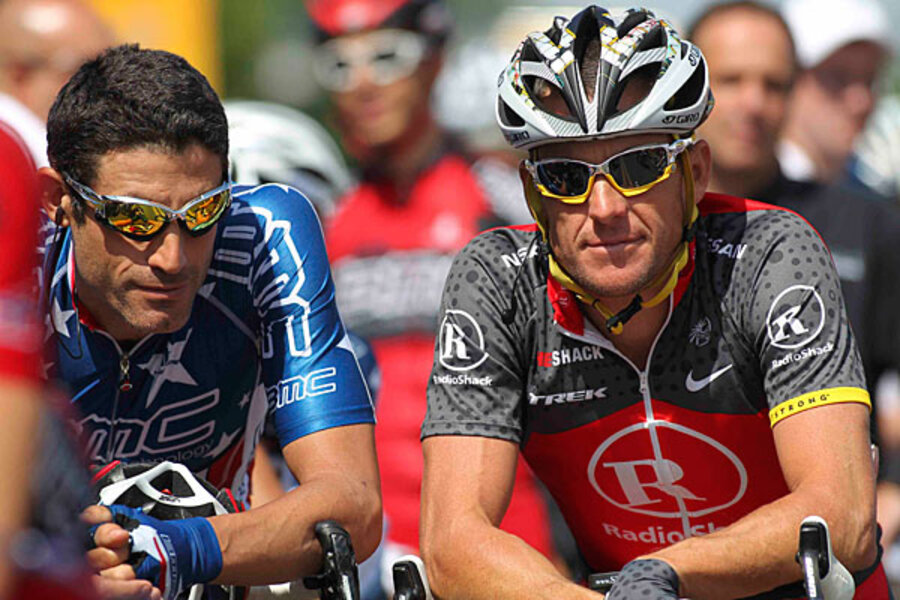Lance Armstrong's former teammates testify against him
Loading...
Lance Armstrong challenged the U.S. Anti-Doping Agency to name names and say what it had on him.
On Wednesday, it did.
The anti-doping body revealed a group of 11 former Armstrong teammates — some loyal, some estranged — who each provided evidence of drug use on the U.S. Postal Service team. USADA Chief Executive Travis Tygart called it "the most sophisticated, professionalized and successful doping program that sport has ever seen."
USADA will deliver its reasoned decision against Armstrong later Wednesday, a summary of the facts it used to hand him a lifetime suspension and erase his titles. The organization has banned the seven-time Tour de France winner from competition for life and declared his victories null and void.
In a news release previewing the decision, Tygart said it would include more than 1,000 pages of evidence. He listed 11 of Armstrong's former teammates, including George Hincapie, Floyd Landis and Tyler Hamilton, as among those providing evidence that led to the sanction.
Tygart said the evidence shows the code of silence that dominated cycling has been shattered.
"It took tremendous courage for the riders on the USPS Team and others to come forward and speak truthfully," he said. "It is not easy to admit your mistakes and accept your punishment. But that is what these riders have done for the good of the sport."
Armstrong's attorney, Tim Herman, called the report "a one-sided hatchet job — a taxpayer funded tabloid piece rehashing old, disproved, unreliable allegations based largely on axe-grinders, serial perjurers, coerced testimony, sweetheart deals and threat-induced stories."
Aware of the criticism it has faced from Armstrong and his legion of followers, Tygart insisted USADA handled this case under the same rules as any other. He pointed out that Armstrong was given the chance to take his case to arbitration and he declined, choosing to accept the sanctions instead.
"We focused solely on finding the truth without being influenced by celebrity or non-celebrity, threats, personal attacks or political pressure because that is what clean athletes deserve and demand," Tygart said.
In delivering the report to the International Cycling Union, Tygart called for the federation to create a meaningful program to help clean up the sport.
The USADA report was widely expected to pull together and amplify allegations that have followed Armstrong ever since he beat cancer and won the Tour for the first time. At various times and in different forums, Landis, Hamilton and others have said that Armstrong encouraged doping on his team and used banned substances himself.
While the arguments about Armstrong will continue among sports fans — and there is still a question of whether USADA or UCI has ultimate control of taking away his Tour titles — the new report puts a cap on the official investigations. Armstrong was cleared of criminal charges in February after a federal grand jury probe that lasted about two years.
Tygart said evidence from 26 people, including 15 riders with knowledge of the U.S. Postal Service Team's doping activities, provided material for the report. It was with the USPS team that Armstrong won all but one of his Tour titles from 1999-2005.
Other cyclists named in the news release were Frankie Andreu, Michael Barry, Tom Danielson, Levi Leipheimer, Stephen Swart, Christian Vande Velde, Jonathan Vaughters and David Zabriskie.
In a letter sent to USADA attorneys Tuesday, Herman dismissed any evidence provided by Landis and Hamilton, calling them "serial perjurers and have told diametrically contradictory stories under oath."
Hincapie's role in the investigation could be more damaging, as he was one of Armstrong's closest and most loyal teammates through the years.
"Two years ago, I was approached by U.S. federal investigators, and more recently by USADA, and asked to tell of my personal experience in these matters," the cyclist said in a statement published shortly after USADA's release. "I would have been much more comfortable talking only about myself, but understood that I was obligated to tell the truth about everything I knew. So that is what I did."
Hincapie's two-page statement did not mention Armstrong by name.
Tygart said all the evidence in the Armstrong case and the cases of six other riders targeted in USADA's investigation would be made available on the agency's website later Wednesday.
Two other players in the Postal team's circle, Dr. Michele Ferrari and Dr. Garcia del Moral, also received lifetime bans as part of the case.
Three other members of the USPS team will take their cases to arbitration. They are team director Johan Bruyneel, team doctor Pedro Celaya and team trainer Jose "Pepe" Marti.
Armstrong chose not to pursue the case and instead accepted the sanction, though he has persistently argued that the USADA system was rigged against him, calling the agency's effort a "witch hunt" that used special rules it doesn't follow in all its other cases.The UCI has asked for details of the case before it decides whether to sign off on the sanctions. The federation has 21 days to appeal the case to the Court of Arbitration for Sport.
USADA has said it doesn't need UCI's approval and Armstrong's penalties already are in place.
UCI President Pat McQuaid, who is in China for the Tour of Beijing, did not respond to telephone calls from The Associated Press requesting comment.
The report also will go to the World Anti-Doping Agency, which also has the right to appeal, but so far has supported USADA's position in the Armstrong case.
ASO, the company that runs the Tour de France and could have a say in where Armstrong's titles eventually go, said it has "no particular comment to make on this subject."







